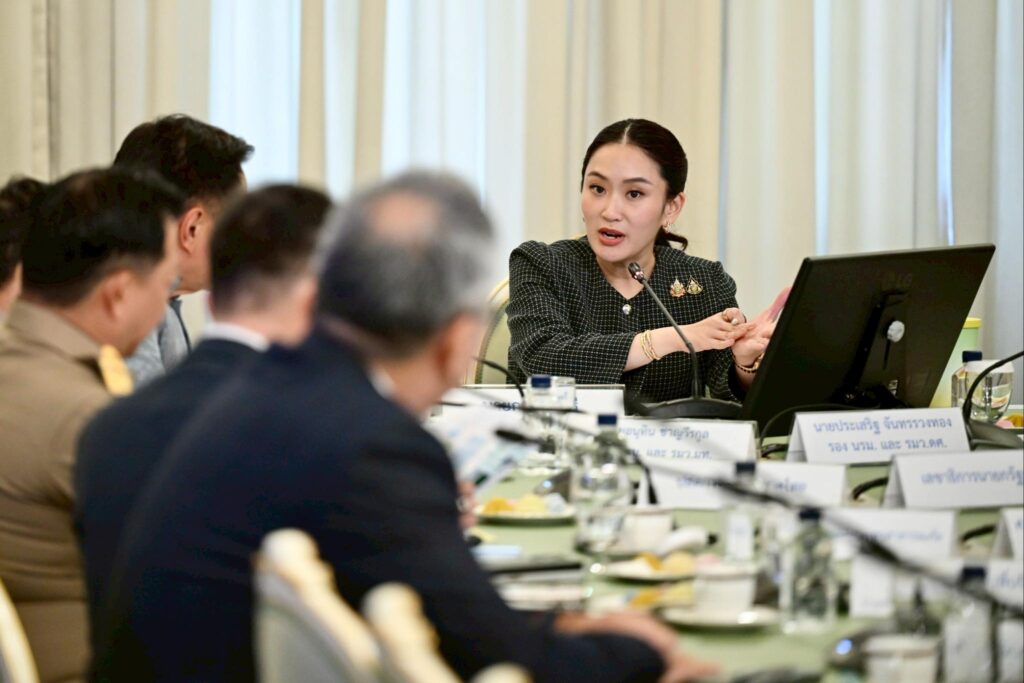The revamp focuses on a poorly prepared early warning and public alert system, disaster prevention and mitigation plans, disaster-related curricula, and others
Prime Minister Paetongtarn Shinawatra has held consecutive meetings, including the Cabinet meeting today, to try to address the unresolved challenges brought by major disasters, especially the most recent earthquake on Friday.
Consulting with her Cabinet members as well as concerned agencies, she has come up with a series of instructions for concerned ministries and agencies to revise and develop disaster management measures, focusing especially on preparedness and response involving public communication and disaster mitigation plans.
The PM instructed the Foreign Affairs Ministry to consult with the international community and experts to share their knowledge and experience with Thailand. The meeting with them should be held the soon, she instructed the ministry.
The Mineral Resources Department, meanwhile, must invite experts on disaster management and related science to brainstorm and come up with recommendations for the government on how to develop comprehensive disaster prevention and mitigation plans for the country.
The Interior Ministry must develop the disaster prevention and mitigation plans with a clear flowchart, seen as a weak point in the major earthquake on Friday, within 30 days. The Education Ministry, on the other hand, was instructed to develop disaster-related curricula for long-term preparedness and response.
Delayed SMS
The most challenging task at hand is an early warning and public alert system. PM Paetongtarn expressed concerns about immediate disasters like earthquakes and wished to see an effective system in place within the next three months.
The focus now is on how to alert the public as quickly as possible, realising that eary warnings can hardly be issued for this kind of disaster. She has instructed the concerned agencies, including the Meteorological Department (TMD), the Department of Disaster Prevention and Mitigation (DDPM), the Publid Relations Department (PRD), and a few others to overhaul their coordination to improve public messages as well as communication procedures.
The government plans to shift modes of communication to nationwide televised announcements and alerts (TV Pool), and cell broadcast, the system through which text messages could be sent to the targets in a large number at once.
PM Paetongtarn has assigned the Public Relations Department to be the center of the government’s dissemination of disaster-related information. The manual SMS text messaging will also be shifted to the cell broadcast system to reach individuals promptly.
At present, the manual SMS message dissemination by the networks can send 200,000 at once. There are about 150 million mobile phones in the country, 70 million of which use the Android system, while 50 million more use iPhones, according to the government.
The PM wishes to see the improved system work immediately. So, she has cut short the process by bypassing the National Broadcasting and Telecommunications Commission’s role, while instructing the DDPM to directly send the information to mobile network operators, which are Cell Broadcast Center, and without spending more than one hour to go over the information sent to it from the TMD.
But at this point, the cell broadcast system is not completed yet, pending the Cell Broadcast Entity, which is the DDPM, to set up its infrastructure, and has to wait until July. As a result, the information can be sent through CBC alone to Android-based phones, which are 70 million. The rest will receive messages from the government, if necessary, via SMS until the complete system is in place, according to the PM.
The collapsed State Audit Office building
The collapsed under-construction building of the State Audit office in Chatuchak has escalated into an investigation into possible corruption and business misconduct by investors from China, as the initial examination by the Industrial Ministry found substandard steel bars used in the core structures of the building. Some of them were supplied from a closed factory under the ministry’s order in Rayong province late last year.
PM Paetongtarn has instructed a new probe panel to find facts within seven days.
So far, the Department of Special Investigation (DSI) has accepted the case for investigation. It has initially found that as many as 17 companies are nominees involved in the construction company, ITD-CREC, which is a joint venture of Italian-Thai Development Plc and China Railway Number 10 (Thailand). (The status of China Railway Number 10 (Thailand) is still unclear. The DSI has found in its latest investigation that some Thai nationals are found to hold 51% shares of the company as well as several others, raising speculation that they are nominees for foreign nationals.)
ITD also has a joint venture, ITD – CREC No.10 Joint Venture Co., Ltd., with China Railway No.10 Engineering Group Co., Ltd. It is a contractor to build the 30 km section of the 250 km Thai-Chinese high-speed railway system, Phase 1: Bangkok–Nakhon Ratchasima Section. The project is part of the Bangkok-Nong Khai High Speed Railway Development project, which is in congruence with China’s Belt and Road Initiative (BRI), under the official cooperation between Thailand and China.
CREC No.10 is under China Railway Group Limited (CREC), based in Beijing, China. CREC was set up in late 2007 by the China Railway Engineering Corporation (CRECG), or the defunct General Bureau of Capital Construction under China’s Ministry of Railways. CRECG is now under the Steering Committee for Large Centrally Administered State-owned Enterprise. In late 2017, CREC was transformed from a company to “a wholly funded state-owned enterprise” and renamed China Railway Engineering Co., Ltd., according to its official website.
The Commerce Ministry has also found that the joint venture has acquired 11 state contracts, 10 of which are under construction. The Department of Public Works and Town & Country Planning, at the same time, has been instructed to come up with proper measures to inspect construction and buildings to ensure their standard and safety.
Read: EDITORIAL: The lessons we have never learned
Indie • in-depth online news agency
to “bridge the gap” and “connect the dots” with critical and constructive minds on development and environmental policies in Thailand and the Mekong region; to deliver meaningful messages and create the big picture critical to public understanding and decision-making, thus truly being the public’s critical voice


